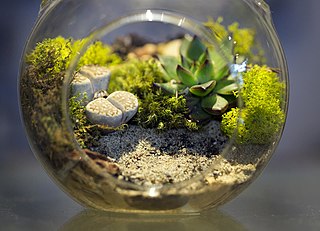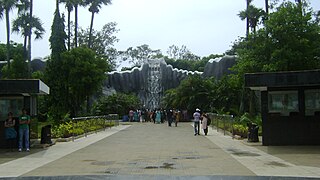Herpetoculture is the keeping of live reptiles and amphibians in captivity, whether as a hobby or as a commercial breeding operation. "Herps" is an informal term for both reptiles and amphibians. It is undertaken by people of all ages and from all walks of life, including career herpetologists, professional reptile or amphibian breeders, and casual hobbyists.

Bristol Zoo is a zoo in the city of Bristol in South West England. The zoo's stated mission is to "[maintain and defend] biodiversity through breeding endangered species, conserving threatened species and habitats and promoting a wider understanding of the natural world".

Pogonas are a genus of reptiles containing eight lizard species which are often known by the common name bearded dragons. The name "bearded dragon" refers to the "beard" of the dragon, the underside of the throat, which can turn black for a number of reasons, most often as a result of stress. They are a semi-arboreal species, spending significant amounts of time on branches, in bushes, and near human habitation. Pogona species bask on rocks and exposed branches in the mornings and afternoons. They are found throughout much of Australia in a wide range of habitats such as deserts, shrublands and Eucalyptus woodlands.

An ectotherm, is an organism in which internal physiological sources of heat are of relatively small or quite negligible importance in controlling body temperature. Such organisms rely on environmental heat sources, which permit them to operate at very economical metabolic rates. Some of these animals live in environments where temperatures are practically constant, as is typical of regions of the abyssal ocean and hence can be regarded as homeothermic ectotherms. In contrast, in places where temperature varies so widely as to limit the physiological activities of other kinds of ectotherms, many species habitually seek out external sources of heat or shelter from heat; for example, many reptiles regulate their body temperature by basking in the sun, or seeking shade when necessary in addition to a whole host of other behavioral thermoregulation mechanisms. For home captivity of pet reptiles, owners can use a UVB/UVA light system to assist the animals' basking behaviour.

Anolis carolinensis is an arboreal anole lizard native to the southeastern United States and introduced elsewhere. Other common names include the green anole, American green anole, American anole, and red-throated anole. It is also sometimes referred to as the American chameleon due to its ability to change color from several brown hues to bright green, and its somewhat similar appearance and diet preferences. However it is not a true chameleon and the nickname is misleading although it can camouflage.

A zookeeper, sometimes referred as animal keeper, is a person who manages zoo animals that are kept in captivity for conservation or to be displayed to the public. They are usually responsible for the feeding and daily care of the animals. As part of their routine, the zookeepers may clean the exhibits and report health problems. They may also be involved in scientific research or public education, such as conducting tours and answering questions.

A vivarium is an area, usually enclosed, for keeping and raising animals or plants for observation or research. Often, a portion of the ecosystem for a particular species is simulated on a smaller scale, with controls for environmental conditions.

The Burmese python is one of the five largest species of snakes in the world. It is native to a large area of Southeast Asia but is found as an invasive species elsewhere. Until 2009, it was considered a subspecies of Python molurus, but now is recognized as belonging to a distinct species.

A reef aquarium or reef tank is a marine aquarium that prominently displays live corals and other marine invertebrates as well as fish that play a role in maintaining the tropical coral reef environment. A reef aquarium requires appropriately intense lighting, turbulent water movement, and more stable water chemistry than fish-only marine aquaria, and careful consideration is given to which reef animals are appropriate and compatible with each other.

A cage is an enclosure often made of mesh, bars, or wires, used to confine, contain or protect something or someone. A cage can serve many purposes, including keeping an animal or person in captivity, capturing an animal or person, and displaying an animal at a zoo.

Longleat Safari and Adventure Park in Wiltshire, England, was opened in 1966 as the first drive-through safari park outside Africa. The park is situated in the grounds of Longleat House, an English stately home which is open to the public and is the home of the 7th Marquess of Bath. Longleat Safari Park and the concept of safari parks were the brainchild of Jimmy Chipperfield (1912–1990), former co-director of Chipperfield's Circus.

The three-toed box turtle is a subspecies within the genus of hinge-shelled turtles commonly referred to as box turtles. This subspecies is native to the south-central part of the United States and is the official reptile of the state of Missouri.

The Mexican black kingsnake is part of the larger colubrid family of snakes, and a subspecies of the common kingsnake, which is debated by herpetologists to contain as many as 10 unique varieties. This species occupy rocky areas and places lush with vegetation in various regions of the Sonoran Desert, Northwestern Sinaloa, Mexico, and small parts of Arizona. In captivity, they can remain in excellent health through a strict diet of mice and generally require a temperature gradient between 21 and 29 degrees Celsius.
The Afghan leopard gecko is one of the five subspecies of the common leopard gecko, a small to midsized lizard belonging to the family Gekkonidae. This subspecies was first discovered by entomologist Carl Julius Bernhard Börner in 1976. It is much smaller than other leopard gecko subspecies.

The Mwanza flat-headed rock agama or the Spider-Man agama, because of its coloration, is a lizard reptile in the family Agamidae, found in Tanzania, Rwanda, and Kenya.

Arignar Anna Zoological Park, also known as the Vandalur Zoo, is a zoological garden located in Vandalur, is in the southwestern part of Chennai, Tamil Nadu, about 31 kilometres (19 mi) from the Chennai Central and 15 kilometres (9.3 mi) from Chennai Airport. Established in 1855, it is the first public zoo in India. It is affiliated with the Central Zoo Authority of India. Spread over an area of 602 hectares, including a 92.45-hectare (228.4-acre) rescue and rehabilitation centre, the park is the largest zoological park in India. The zoo houses 2,553 species of flora and fauna across 1,265 acres (512 ha). As of 2012 the park houses around 1,500 wild species, including 46 endangered species, in its 160 enclosures. As of 2010, there were about 47 species of mammals, 63 species of birds, 31 species of reptiles, 5 species of amphibians, 28 species of fishes, and 10 species of insects in the park. The park, with an objective to be a repository of the state's fauna, is credited with being the second wildlife sanctuary in Tamil Nadu after Mudumalai National Park.

Animal fancy is a hobby involving the appreciation, promotion, or breeding of pet or domestic animals.
The Chennai Snake Park, officially the Chennai Snake Park Trust, is a not-for-profit NGO constituted in 1972 by herpetologist Romulus Whitaker and is India's first reptile park. Also known as the Guindy Snake Park, it is located next to the Children's Park in the Guindy National Park campus. Located on the former home of the Madras Crocodile Bank Trust, the park is home to a wide range of snakes such as adders, pythons, vipers, cobras and other reptiles. The park gained statutory recognition as a medium zoo from the Central Zoo Authority in 1995.

Glasgow Zoo, or Calderpark Zoo, was a 99-acre (40 ha) zoological park in Baillieston, Glasgow, Scotland.
An African rock python killed two boys in Campbellton, New Brunswick, Canada on August 5, 2013. The boys, who were aged four and six, were sleeping in an apartment above their friend's father's pet store. The python – which had been in a specially made enclosure in the apartment – had escaped, crawled through an air duct, and fallen through a ceiling tile above where the boys were sleeping. Following the incident, the python was euthanized. The python's owner was charged with criminal negligence for not preventing the deaths, but was found not guilty in a jury trial in November 2016.